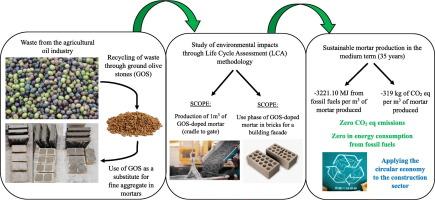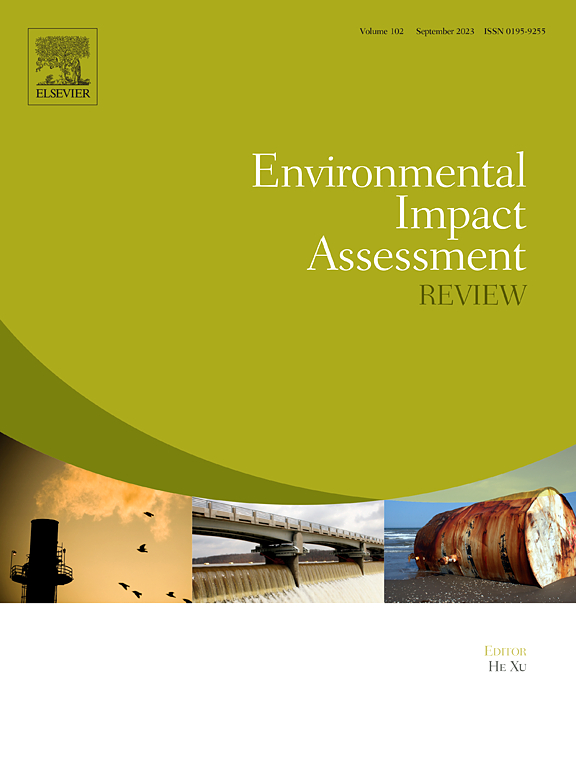Environmental assessment of the use of ground olive stones in mortars. Reduction of CO2 emissions and production of sustainable mortars for buildings
IF 9.8
1区 社会学
Q1 ENVIRONMENTAL STUDIES
引用次数: 0
Abstract
The current construction sector needs to include sustainability in the near future. The use of recycled aggregates (RA) instead of natural aggregates (NA) is proving to be an effective strategy to achieve more sustainable materials. In the case of Spain and within the agricultural sector, olive stones have great potential for use as RA, justified by several studies on their technical feasibility. This research evaluates environmentally through a Life Cycle Assessment (LCA) methodology the incorporation of ground olive stone (GOS) as a partial substitute for natural fine aggregate in 1m3 of mortar in different percentages. In a first phase, the environmental impacts are analysed with the scope of production of 1m3 of mortar (cradle to gate). Subsequently, a long-term assessment is carried out in the use phase to determine the environmental benefits of using the doped mortar in a façade for a new building. Among the most significant and innovative results, it is shown that for a doping percentage of 20 %, CO2 emissions are reduced by 137.9 % for a simulation period of use of 35 years. This translates into preventing the net emission of 319.43 kg CO2 eq/m3 of doped mortar into the atmosphere. In addition to avoiding the consumption of 3221.10 MJ/m3 of fossil fuels. All these results support the medium- and long-term environmental profitability of doping the mortar with GOS. Globally, it brings new environmental knowledge to the use of GOS as RAs over NAs and, jointly, to the sector's environmental sustainability objective.

对灰泥中使用磨碎的橄榄石进行环境评估。减少二氧化碳排放和生产可持续的建筑砂浆
当前的建筑行业需要在不久的将来实现可持续发展。事实证明,使用再生骨料(RA)代替天然骨料(NA)是实现材料可持续性的有效策略。在西班牙和农业领域,橄榄石作为再生骨料具有巨大的使用潜力,有关其技术可行性的多项研究也证明了这一点。本研究通过生命周期评估(LCA)方法,对在 1 立方米砂浆中以不同比例加入磨碎的橄榄石(GOS)作为天然细骨料的部分替代品进行了环境评估。在第一阶段,分析了 1 立方米砂浆生产(从摇篮到大门)对环境的影响。随后,在使用阶段进行长期评估,以确定在新建筑外墙中使用掺杂砂浆的环境效益。其中最重要和最具创新性的结果表明,如果掺杂比例为 20%,在 35 年的模拟使用期内,二氧化碳排放量可减少 137.9%。这意味着每立方米掺杂砂浆可避免向大气净排放 319.43 千克二氧化碳当量。此外,还避免了 3221.10 兆焦耳/立方米化石燃料的消耗。所有这些结果都证明了在砂浆中掺入 GOS 的中长期环境效益。在全球范围内,它为使用 GOS 作为 RA 而不是 NA 带来了新的环境知识,同时也为该行业的环境可持续发展目标带来了新的环境知识。
本文章由计算机程序翻译,如有差异,请以英文原文为准。
求助全文
约1分钟内获得全文
求助全文
来源期刊

Environmental Impact Assessment Review
ENVIRONMENTAL STUDIES-
CiteScore
12.60
自引率
10.10%
发文量
200
审稿时长
33 days
期刊介绍:
Environmental Impact Assessment Review is an interdisciplinary journal that serves a global audience of practitioners, policymakers, and academics involved in assessing the environmental impact of policies, projects, processes, and products. The journal focuses on innovative theory and practice in environmental impact assessment (EIA). Papers are expected to present innovative ideas, be topical, and coherent. The journal emphasizes concepts, methods, techniques, approaches, and systems related to EIA theory and practice.
 求助内容:
求助内容: 应助结果提醒方式:
应助结果提醒方式:


